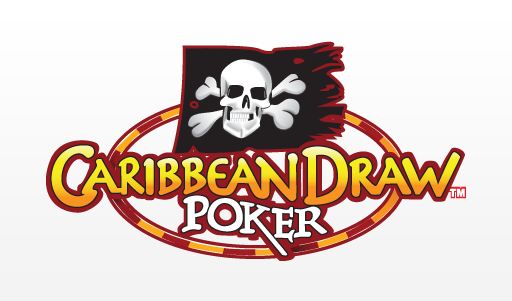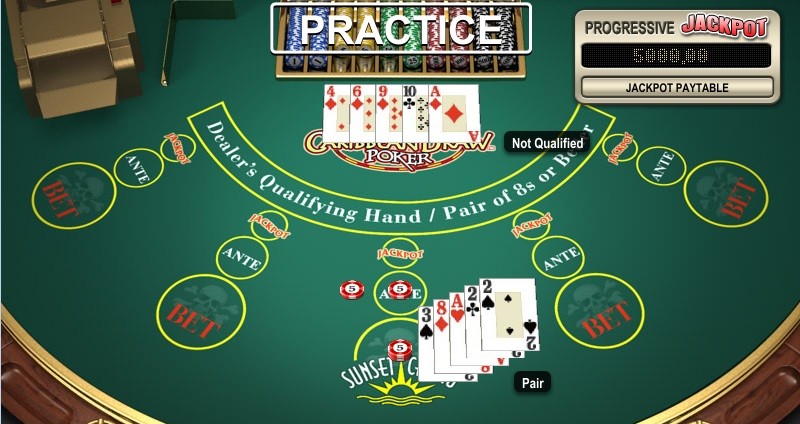
Part of the triad of Caribbean-themed table games currently sweeping the casino industry by storm, Caribbean Draw Poker combines elements of blackjack and poker to create an action-packed hybrid table game.
Available on the Microgaming, Real Time Gaming, and Boss Media gaming software platforms, Caribbean Draw Poker should be offered by your favorite online casino, but if it’s not, a simple search should find a few rooms spreading the game. For an idea of what the game looks like within an online casino setting, the Caribbean Draw Poker page on the Bovada Casino platform is a great template for what to expect.
Similar in spirit to Three Card Poker, the Caribbean version of draw poker is a five card game played against the dealer. The game follows the standard ante / bet / fold structure familiar to table game fans while also incorporating the enticing progressive jackpot concept. In addition, generous bonus payouts are made whenever you complete a high ranking poker hand, giving you a great chance to build your bankroll while sticking to smaller sized bets.
The following walkthrough is intended to teach newcomers to Caribbean Draw Poker how to play the game, before moving on to advanced concepts and proper strategy. Even if you’ve never played a hand of a table game before, this primer should leave you feeling knowledgeable about the rules, confident in your strategy, and ready to dive right into the action.
Top Casinos
How to Play in Five Steps
The playing screen for a game of Caribbean Draw Poker is typically designed to resemble most table games on the casino floor. That means you’ll see squares lined out for your five card hand, along with three squares indicating the ante, raise, and jackpot wagers.
Initial Bet
Depending on the software platform in use at your favorite online casino, the betting will usually be made by simply clicking on various chip icons located near the bottom of the screen. These icons depict $1, $2, $5, $10, and $25 chip denominations for the most part, and you can bet any amount you’d like by clicking the right combination of chips.
Should you click incorrectly and bet a bigger chip than you actually wanted to, try clicking the chip again before clicking play and the bet should return to your bankroll. Some software providers have a clear bets button.
Five Cards are Dealt
After placing your mandatory ante bet, the virtual dealer will distribute a five card hand to both you and themselves. Your five cards will obviously be face up, but the dealer’s hand will only have one card exposed. It’s your job to decide whether to play, which will cost an additional wager equal to twice your ante bet, based on the strength of your five cards and the dealer’s up card.
For example, if you bet $10 on the ante bet, and like the look of your five card hand enough to continue, the raise bet must be $20, putting a total of $30 on the line for that hand. However, if your five card hand isn’t up to snuff, you can always elect to fold and surrender the original ante bet without a fight.
Raising the Bet
Should you decide to place the raise bet and face off against the dealer, the next decision you’ll need to make involves discarding and drawing cards. You have the option to discard up to two cards from your five card hand, with those being replaced by the next cards from the top of the deck.
In the event you make a pat five card hand, such as a straight, flush, or full house, obviously, you don’t need to draw additional cards. For the most part, though, you’ll be dealt lesser hands like one pair or even ace high, so you’ll usually be discarding one or two cards and hoping to improve on the draw.
Discard and Draw
After selecting which cards to discard (for more on this crucial decision, see the strategy section below), the dealer will also run through the discard / draw process. While you have the benefit of decision making when discarding, the dealer must rely on a preset system determining their actions, much like a blackjack dealer must hit on all hands below 17. To make sense of the dealer’s decisions, keep the following rules in mind:
Dealers must stand on any 5 card pat hands, discard one card with four of a kind or two pair, discard two cards with three of a kind or one pair, discard one card with either a four card flush draw or four card straight draw, and discard the two lowest cards when playing only a high card hand.
Paying the Winner
Once you discard and draw, followed by the dealer, their hand will then be exposed for comparison to see which hand is highest. An important concept to keep in mind here involves qualifying hands because the dealer must show down a pair of eights or better to qualify for the pot. When the dealer does not produce a qualifying hand, your ante bet will be paid out at a 1 to 1 ratio, while your raise bet is returned as a push. When the dealer does qualify, however, your ante bet will be paid out at 1 to 1, while your raise bet is paid out depending on the strength of your hand.
Hand Rankings and Odds
The following table provides a great guide for determining payout amounts on high hands when the dealer happens to qualify:
| Hand Rank | Description | Ante | Raise Odds |
| Royal Flush | A, K, Q, J, 10 of same suit | 1:1 | 100:1 |
| Straight Flush | 5 cards of the same suit in sequence | 1:1 | 50:1 |
| 4 of a Kind | 4 cards of same rank | 1:1 | 20:1 |
| Full House | 3 of a Kind, plus a pair | 1:1 | 7:1 |
| Flush | 5 cards of same suit | 1:1 | 5:1 |
| Straight | 5 cards in sequence, mixed suits | 1:1 | 3:1 |
| 3 of a Kind | 3 cards of same rank | 1:1 | 2:1 |
| Two pair | 2 pairs of different rank | 1:1 | 1:1 |
| One pair | 1 pair (2 cards) of same rank | 1:1 | 1:1 |
| High card | 3 cards of same rank | 1:1 | 1:1 |
So as an example, let’s say you placed an ante bet of $10 and liked your hand enough to make the additional $20 raise bet as well. If you happen to make four of a kind, either as a pat hand or after drawing cards, you’ll desperately want the dealer’s hand to qualify with a pair of eights or better. When it does, your four of a kind will be the winner, and your ante bet will be paid out at 1 to 1 for a $10 profit. Your raise bet, however, will be paid out at the 20:1 listed above, meaning you’ll win an additional $400 on top of that.
You can also elect to place an additional wager on the progressive jackpot associated with your room’s table game section. Usually, a running jackpot will be tied to all three Caribbean table game variants, so the total is built by all three games, and shared by winners from any of the three.
This bet entitles you to extra bonus payouts when you make huge hands and beat a qualifying dealer hand, but most experts warn against making this wager on a consistent basis, as the house edge is not in the player’s favor.
Proper Strategy
 Boasting a low house edge similar to blackjack and baccarat, Caribbean Draw Poker is a favorite for gamblers who like to take the safe side. Of course, this can change if you deviate from optimal strategy, so it’s best to stick to the following game plan when discarding and drawing cards.
Boasting a low house edge similar to blackjack and baccarat, Caribbean Draw Poker is a favorite for gamblers who like to take the safe side. Of course, this can change if you deviate from optimal strategy, so it’s best to stick to the following game plan when discarding and drawing cards.
To utilize the table below, simply identify the lowest numbered option on the list that you’re able to form with your five card hand. After you’ve found the best possible three or four card combination (obviously five card pat hands should remain intact), just discard the remaining card and hope to improve.
To read this chart, consider the following example: You are dealt the 10H, 8H, 5H, 4H, and 10S. In this scenario, you could either hold the made pair of tens, or you could hold the four card flush and hope to complete it on the draw. The chart below lists a four card flush as the sixth-ranked hand while a pair of tens is ranked slightly worse at number seven. So, under this strategic guideline, you should keep the four flush and discard the pair of tens. This may seem counterintuitive at first, but when you consider the additional payout awarded for flushes, along with the odds of completing your hand, this play is actually optimal in terms of expected value.
For another strategy primer, you can make use of this ingenious Caribbean Draw Strategy Calculator to plug in various five card combinations and dealer up cards. The tool will then produce the optimal play given the scenario, so you can experiment with different five card deals to get a better feel for which plays are the most profitable over the long run.
| #1 | Royal Flush / straight flush / four of a kind / full house / flush |
| #2 | Suited KQJT |
| #3 | Straight / three of a kind / two pair |
| #4 | Four to straight flush |
| #5 | Pair QQ through AA |
| #6 | Four to flush |
| #7 | Pair TT through JJ |
| #8 | Four to outside straight |
| #9 | Pair 99 |
| #10 | Three to Royal Flush |
| #11 | Three to straight flush without gaps |
| #12 | Pair 22 through 88 |
| #13 | Three to straight flush with gaps |
| #14 | Three to flush with 2 highest cards of hand |
| #15 | Four to inside straight with the highest card of hand |
| #16 | Three to flush with either highest or 2nd highest card of hand |
| #17 | Four to inside straight without highest card of hand |
| #18 | Three cards eight or better with dealer up card of 8 or better |
| #19 | Three to flush without highest or 2nd highest card of hand |
| #20 | Three to Straight with no gaps, with either highest or 2nd highest card of hand |
| #21 | Discard two lowest cards unless dealer up card ranks above highest card of hand |
| #22 | Fold if dealer up card ranks above highest card of hand |






